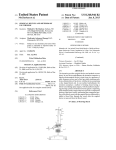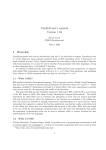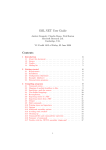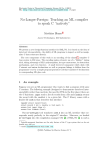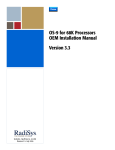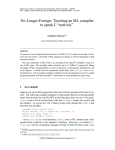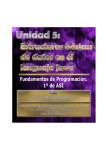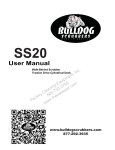Download Interlanguage Working Without Tears: Blending SML with Java
Transcript
Interlanguage Working Without Tears:
Blending SML with Java
Nick Benton
Andrew Kennedy
Microsoft Research Ltd., Cambridge, U.K.
{nick,akenn}@microsoft.com
Abstract
A good foreign-language interface is crucial for the success
of any modern programming language implementation. Although all serious compilers for functional languages have
some facility for interlanguage working, these are often limited and awkward to use.
This article describes the features for bidirectional interlanguage working with Java that are built into the latest
version of the MLj compiler. Because the MLj foreign interface is to another high-level typed language which shares a
garbage collector with compiled ML code, and because we
are willing to extend the ML language, we are able to provide unusually powerful, safe and easy to use interlanguage
working features. Indeed, rather then being a traditional
foreign interface, our language extensions are more a partial
integration of Java features into SML.
We describe this integration of Standard ML and Java,
first informally with example program fragments, and then
formally in the notation used by The Definition of Standard
ML.
1
Introduction
Functional language implementations nearly all provide
some way to call external C functions [4, 9, 12], but direct interworking with a low-level, non-typesafe, language with no
garbage collection is never going to be easy or pretty. Most
functional programmers never use the foreign interface except via functionally-wrapped libraries written by compiler
experts.
The importance of good foreign language interfaces for
functional languages is now widely recognised, particularly
given the wider trend towards mixed-language componentbased programming. Recent years have seen a number
of functional interfaces to language-independent component
architectures, notably COM (see, for example, [6, 11]) and
CORBA [10]. To quote [6]:
“Programming languages that do not supply a
foreign-language interface die a slow, lingering
death – good languages die more slowly than bad
ones, but they all die in the end.”
To appear in the 4th ACM International Conference
on Functional Programming, September 1999, Paris,
c
France. Copyright
1999 by ACM, Inc.
Download the current version of the MLj compiler
from http://www.dcs.ed.ac.uk/home/mlj/
One of the main motivations for the design of MLj [1],
a compiler for Standard ML that generates Java bytecodes,
was to provide a foreign-language interface that would give
ML programmers access to the extensive libraries available
in Java. We expected to be able to implement a much more
useful and convenient foreign language interface to Java than
is possible for C because the ‘semantic gap’ between ML and
Java is comparatively small:
• Both languages are strongly typed, and there are some
good correspondences between the basic types in the
two languages. For example:
– The numeric types are a close match;
– Strings are immutable vectors of (possibly-null)
characters in both languages;
– Array bounds are checked in both languages;
– Neither language has explicit pointer types.
• Both languages have automatic storage management.
Furthermore, because we compile ML code to Java
bytecodes, we actually use the same garbage collector
for ML and Java objects so there is no need to deal with
references between independently managed heaps.
• Exception handling in the two languages is similar.
There are, however, still significant differences between the
two languages; the concepts of objects, classes, inheritance
and dynamic method dispatch which are at the heart of
Java have no natural counterparts in ML, and Java lacks
many features of ML, such as parametric polymorphism and
higher-order functions. We did not wish to burden users
with the complexities of a separate Interface Definition Language (IDL), as is used for COM and CORBA, so the natural
(if unusually bold) approach was to extend SML with types
and terms corresponding to Java constructs. Doing this well
is a very tricky language design problem: the (unattainable)
ideal would be an object-oriented conservative extension of
ML which still maintains the spirit of ML but which also
corresponds naturally and predictably to the type system of
Java.
The first version of MLj (release 0.1) extended SML with
types and syntax which covered essentially all of Java. However, the two worlds were kept fairly separate. For example, the type Java.int represented Java language integers
(passed to or from external Java code) and converting between this type and ML’s int type required an explicit
open javax.swing java.awt java.awt.event
_classtype SampleApplet () : JApplet ()
with local
val prefix = "Counter: "
val count = ref 0
val label = JLabel(prefix ^ "0", JLabel.CENTER)
fun makeButton (title, increment) =
let
val button = JButton (title:string)
val listener =
ActionListener ()
with
actionPerformed(e : ActionEvent option) =
(count := !count + increment;
label.#setText(prefix ^ Int.toString(!count)))
end
in
button.#addActionListener(listener);
button
end
in
init () =
let
val SOME pane = this.#getContentPane ()
val button1 = makeButton ("Add One", 1)
val button2 = makeButton ("Add Two", 2)
in
pane.#add(button1, BorderLayout.WEST);
pane.#add(label, BorderLayout.CENTER);
pane.#add(button2, BorderLayout.EAST);
end
end
use and definition of Java interfaces, and the formalisation
of certain aspects.
2
Design goals
We wanted ML code to be able to read and write external Java fields, call external Java methods and treat external Java objects in a first-class way – storing them in ML
data structures, passing and returning them from ML functions. We also wanted ML code to be able to define new
Java classes which extend existing external classes (and implement external interfaces) with methods written in ML.
These classes should be accessible and usable either from
within the ML program or by other external Java code.
In addition to these basic goals, we wanted the interface
to have a certain ‘flavour’. At first we took the view that
the interface could be slightly ugly when compared with ML
itself, as it would only be used by library-writers to provide
a functional wrapper around an existing Java package; indeed, the strangeness of any new syntax would serve as reminder that the programmer was doing something reserved
for experts. However, once we discovered how useful and
pleasant it was to have straightforward, safe interoperability with Java’s standard library code and third-party Java
applications (and sometimes even to develop new mixedlanguage applications from scratch), we began to think that
this should be made as convenient and natural as possible.
Therefore in the most recent version of the foreign-language
interface we have aimed to provide:
• Simplicity: the syntax used to access Java classes and
to create new ones should be as lightweight as possible so that a programmer can use it without to much
of a mental context-switch. To attain simplicity as
many ML concepts as possible were re-used (for example, packages are identified with structures and subpackages with substructures) but this was done only
where it makes sense semantically (for example, static
methods are like ML functions but non-static (virtual)
methods are not).
Figure 1: A sample applet in MLj
Java.fromInt or Java.toInt coercion, which would actually disappear during compilation because ML’s int is represented as Java’s int in the compiled code. The extensions
for creating classes from within ML included new keywords
for all Java class and method attributes, even where these
overlapped conceptually with existing ML concepts. For
example, the namespace management of Java’s static final
fields and static methods provided by classes overlaps the
scoping of ML value bindings provided by the module system, and mutable fields are similar to ML refs.
Experience with the MLj 0.1 extensions showed that they
were extremely useful, but that there was plenty of scope for
improvement. Amongst other things, the strict separation
of primitive types was unnecessarily annoying, there was too
much baroque syntax associated with the embedding of Java
in ML (some of which was rarely used because there were
better ways of using existing ML constructs to achieve the
same effect) and one often wished to treat Java fields and
methods in a more first-class way.
This article describes the revised design of the interlanguage working extensions that is being implemented for
the next version of MLj and the rationale for that design.
The new extensions are much more of an integration of
Java concepts within ML than an interface between the
two languages, though for compatability with SML, we have
stopped short of trying to design a fully-fledged ‘natural’
object-oriented extension of ML. We also sketch a formalisation in the style of the Definition of Standard ML [13].
We assume a knowledge of ML and a passing familiarity
with Java. Note that for clarity of presentation we omit
certain features of the ML-Java interface, in particular, the
• Compatibility: correct programs written using SML’97
should typecheck and execute without alteration. This
severely constrained the syntax extensions that we
could use, but we believe that our design is tasteful
and unobtrusive. We have not quite managed to preserve all the equations which hold in SML’97 since, for
example
("h"^"i","h"^"i")
let val x="h"^"i" in (x,x) end
and
are not contextually equivalent (as Java can check object identity).
• Safety: one pleasant aspect of Java is that type safety
is built-in. In contrast to C, programs cannot corrupt the store, leave pointers dangling, and so on.
However, ML goes further, insisting that values are
bound explicitly at their definition, whereas in Java
the possiblity of a default null value can lead to a
NullPointerException. To retain the spirit of ML, we
are quite strict about values of Java class and array
types, insisting that null values are checked for explicitly.
2
Java notion
primitive type
class name
array type
null value
void type
multiple arguments
mutable fields
package
subpackage
importing a package
static field
static method
non-static field access
non-static method invocation
object creation
casts
instanceof
class definition
private fields
private/package access methods
Java type
boolean
byte
char
double
float
int
long
short
java.lang.String
java.lang.Exception
java.math.BigInteger
java.util.Calendar
ML notion/new syntax
base type
type identifier
array type
NONE
unit type
single tuple argument
ref type
structure
substructure
opening a structure
value binding
function binding
.#
.# and .##
function binding
:> in expressions
:> in patterns
_classtype
local declarations
signature matching
Table 2: Correspondence between types in Java and ML
fication does not prescribe particular sizes for numeric types,
instead leaving it up to the implemention. Hence we were
able to match ML base types to Java primitive types, avoiding the need for unpleasant coercions when passing values of
base type to and from Java.1 Table 2 gives the correspondence that we used.
The first eight entries in the table are the Java primitive
types. The remainder are class types, which can be referred
to from within ML using the same syntax as in the Java
language, so for example java.lang.StringBuffer is a Java
string buffer and java.awt.Color is a Java colour. This
syntax works because of the interpretation of Java packages
as structures and subpackages as substructures, discussed
later.
There arises the question of which Java types should be
given equality status within ML, that is, permitted as arguments to ML’s polymorphic equality operator =. For the
base types listed in Table 2, the Basis Library forces the
issue: all are equality types except for real, Real32.real,
exn and Date.date. For other class types, there are three
alternatives: equality by identity (Java’s == operator), userdefined equality (Java’s equals method), or no equality at
all. The first can be rejected as being outside the spirit of
ML, and would in any case conflict with equality-by-value
on strings and big integers; the second also does not have
the right flavour, as = is an equivalence relation for all applicable types in ML, and user-definability would break this;
therefore, we decided to exclude general class types from
having equality status.
Table 1: Analogies between ML and Java
• Power : Many of the constructs that we provide correspond quite closely with those found in the Java language, both syntactically and semantically, but there
were a few places where we were able easily to improve
on Java, for example making methods and fields firstclass, and by introducing a type-case construct.
Just as important as our goals is one of our non-goals.
We decided that, at least at this stage, we would not allow arbitrary ML values (such as closures or values of userdefined datatypes) to be passed to external Java code. This
(a) seemed less useful than the ability to pass values the
other way (any external Java code that could do anything
interesting with an ML value would be better written in
MLj), (b) would potentially compromise safety by, for example, allowing Java code to mutate supposedly immutable
ML values, and (c) would require us to use a predictable
uniform representation for ML values, which would inhibit
many of the optimisations performed by our compiler. However, it seemed unduly restrictive to prevent classes created
from within an MLj program but which do not get exported
to the external Java world from making free use of values of
arbitrary ML types. This introduces a slight complication
into our model, as some MLj classes are now regarded as
exportable and others as purely internal – the details are
explained later.
Table 1 summarizes the correspondence between Java
concepts and existing SML concepts or new features that
we introduced. The code in Figure 1 illustrates many of
these, and we will use it as a running example throughout.
Two buttons control the incrementing of a common counter
that is displayed in the centre. The code is for JavaSoft’s
Swing GUI framework.
3
3.1
ML type
bool
Int8.int
char
real
Real32.real
int
Int64.int
Int16.int
string
exn
IntInf.int
Date.date
3.2
Arrays
Java arrays have virtually identical semantics to ML arrays:
their size is fixed at creation-time, indexing starts at zero,
equality is based on identity not value, and an exception
is raised upon out-of-bounds access or update. Therefore
the ML array type constructor array corresponds to Java’s
array type constructor [].
The single glitch is Java’s unsound covariant subtyping
on arrays, and its corresponding dynamic check on array
update to fix up the unsoundness. For ML arrays implemented using Java arrays, this check always succeeds and
is therefore unnecessary, but unfortunately must introduce
some performance overhead.
Types
Primitive and class types
1
In fact, we depart slightly from the basis specification in adopting
Java’s use of Unicode for characters and strings; the basis prescribes
ASCII 8-bit characters.
The Definition of Standard ML [13] does not specify the base
types of the language, and the Standard Basis library speci3
3.3
Null values
does not, so methods with multiple arguments are given a
single tuple argument type. (The alternative, a curried function type, presents no problems but the syntax of method
invocation inside ML would then be very different from the
syntax in Java). Finally, when arguments and results are objects or arrays, their types are interpreted using the option
type constructor as described earlier.
Consider the following two prototypes taken from the
system class java.lang.String:
In the Java language, variables with class or array types
(known collectively in the Java literature as reference types),
are allowed to take on the value null in addition to object
or array instances. Operations such as method invocation,
field access and update, and array access and update, raise
NullPointerException if their main operand is null.
ML does not have this notion, and values must be bound
explicitly when created. Thus operations such as assignment, indirection, and array access and update are inherently safer than the corresponding operations in Java. We
wished to retain this safety in our Java extensions to ML,
and so interpret a value of Java reference type as “non-null
instance”.
Nevertheless, when a Java field of reference type is accessed from ML or a value of reference type is returned from
an external Java method invoked by ML, it may have the
value null and this must be dealt with by the ML code.
Also, it should be possible to pass null values to Java methods and to update Java fields with the null value. Fortunately the ML basis library already defines a type that suits
this purpose perfectly:
public static java.lang.String
copyValueOf(char[], int, int);
public java.lang.String toString();
Their types are interpreted respectively as
char array option * int * int -> string option
and unit -> string option.
3.6
Java permits the overloading of methods: the definition
of multiple methods with the same name within a single
class. The methods are distinguished by their argument
types. Furthermore, method invocations implicitly coerce
arguments up through the class hierarchy. The combination
of these features can lead to ambiguity, which Java compilers resolve statically by picking the most specific method
with respect to an ordering on argument types, rejecting a
program if there is no unique such method.
MLj allows implicit coercions on method invocation using Java’s reference widening coercions together with an additional coercion from τ to τ option for any Java reference
type τ . We do not allow Java’s numeric widening coercions
to be implicit as the ‘spirit of ML’ is to use explicit conversions such as Int64.fromInt for these.
We do not allow ambiguity to be resolved by Java-style
most specific method rules, as these interact unpleasantly
with type inference: our intention is to have typing rules
and an inference algorithm such that a program is accepted
iff there is a unique resolution of all the method invocations
(with respect to the rules). Use of the ‘most specific’ rule
during inference can lead to type variables becoming bound,
and hence ambiguities far from the point of the rule’s application being resolved in unexpected ways.
datatype ’a option = NONE | SOME of ’a
The valOf function (of type ’a option -> ’a) can be used
to extract the underlying value, raising Option when passed
NONE.
We interpret values of Java reference type that cross the
border between ML and Java as values of an option type.
For example, a stand-alone Java application must have a
method main with the following prototype:
public static void main(java.lang.String []);
Inside ML, the single argument to this method is treated as
a value of type
string option array option
meaning “a possibly-null array containing possibly-null
strings”.
3.4
Field types
Java fields qualified by the keyword
and their types are interpreted as
ing option to denote the possibility
jects or arrays. For example, the
java.lang.System class as
final are immutable
indicated above, usof null values for obfield declared in the
4
4.1
public static final java.io.InputStream in;
Accessing Java from ML
Packages, subpackages, and classes
If one ignores the class hierarchy and non-static fields and
methods (i.e. a non-object-oriented fragment of Java), then
Java packages and classes can be seen (and are used) as a
minimal module system, providing a way of carving up the
namespace for fields and methods into manageable chunks.
We therefore chose to model them using the SML module
system.
Top-level packages in the Java world are reflected in ML
as a collection of top-level structures, with subpackages as
substructures. Classes are reflected as three separate bindings: as type identifiers, as values of function type used
to construct instances of the class (discussed later), and as
structures containing value bindings that reflect static fields
and methods. For example, within the package java.lang
(reflected as a structure lang inside a top-level structure
is interpreted as having type java.io.InputStream option.
Fields not qualified by final are mutable and their types
are interpreted using ML’s ref type constructor. So a field
declared by
public static byte[] b;
is given the ML type Int8.int array option ref.
3.5
Overloading and implicit coercions
Method types
Java method types are interpreted as follows. First, void
methods are considered as having unit result type; similarly
methods that take zero arguments have unit argument type.
Second, Java has a syntax for multiple arguments but ML
4
java), the class Integer is mapped to an ML type identifier Integer, to a value identifier Integer, and to a structure Integer. There is no problem having types, values and
structures sharing a name as they inhabit different namespaces in SML.
4.2
val colours =
map (valOf o java.awt.Color.getColor)
["red", "green", "blue"]
Here we have made use of the automatic insertion of the
SOME coercion as discussed in Section 3.6, as the getColor
method is interpreted as having the type
open package
open class-name
Import as open
string option -> java.awt.Color option
but values of type string are passed to it.
Non-static (virtual) method invocation uses the syntax
exp.#method-name, where exp is an expression of class type
and method-name is a method defined or inherited by that
class. There are many examples of this in Figure 1: the
label.#setText invocation again illustrates a coercion from
string to SOME string, and the pane.#add invocation illustrates class coercions (to Component option) and overloading (as the add method has many alternative argument
types).
Packages and classes interpreted as structures can be manipulated like any other structure in SML: they can be rebound,
constrained by a signature, passed to functors, and opened.
Opening of packages-as-structures is analogous to Java’s
import package.* construct; for example, the declaration
open javax.swing in Figure 1 is roughly equivalent to
import javax.swing.*. However, when used with classesas-structures the open mechanism is more powerful, permitting unqualified access to static fields and methods. Also,
subpackages become visible as structures: the sample program opens java.awt and then uses event.ActionEvent to
refer to the java.awt.event.ActionEvent class.
4.3
4.5
Static fields are mapped to ML value bindings. Fields qualified by final really are treated as simple values; an example
of this is the BorderLayout.WEST constant used in Figure 1.
Non-final fields are interpreted as ML value bindings with
ref types. The implementation permits these to be used
in a first-class way, improving on Java. To make this possible, values of Java reference type are compiled as objects
with ‘reader’ and ‘writer’ methods; immediate assignment or
dereferencing compiles to code as efficient as that produced
by a Java compiler. There is however a small performance
hit for ordinary ML ref values that have Java types, as if it
wasn’t for Java these could be implemented more efficiently
by performing access and update inline.
As mentioned earlier, we provide explicit provision for
null values through the use of option types. For example,
the colour constants provided in the java.awt.Color class
have Java declarations such as
val labels = map javax.swing.JLabel ["A", "B"]
4.6
and might be accessed in ML by
(expression)
(pattern)
exp :> ty
id :> ty
val c = (JButton "My button") :> Component
Explicit coercions are sometimes required when passing Java
objects to ML functions, as coercions are only applied implicitly when invoking Java methods.
The same syntax can also be used to cast an object down
to a subclass, with Java’s ClassCastException thrown if the
actual class of the object is not compatible. A safer alternative that combines downcasting with Java’s instanceof
is the use of :> inside ML patterns. This can be used to
provide a construct similar to the TYPECASE of Modula-3 [3]
and other languages. Suppose that a parser was written in
Java and used subclassing of a class Expr to represent different node types. Then we could traverse the parse tree using
case analysis:
val SOME pink = java.awt.Color.pink
Non-static fields (instance variables) are accessed by the
new exp.#field-name syntax. (It is not possible to use a
simple dot notation because there would be no means of
distinguishing such expressions from those used for static
field access). Here exp is an ML expression of class type
and field-name is a Java field name. As with static fields,
non-final fields can be used as first-class ref values.
Methods
Casts and typecase
A new syntax is introduced (borrowed from O’Caml [14, 12])
to denote Java-style casts. It can be used to cast an object
up to a superclass:
public static final java.awt.Color pink;
4.4
class-name exp
In Java, new instances of a class are created using the syntax new class-name(arg1 , . . . , argn ), where argi are the arguments to one of the constructors defined by the class.
We avoid the need for any new syntax in MLj by binding
the class name itself to the constructor function. If there is
more than one constructor, then the binding is overloaded.
For example, the constructors for javax.swing.JButton appear as bindings to the identifier JButton inside the structure javax.swing. This is illustrated in Figure 1 in the
construction of JLabel and JButton objects.
As with methods, constructors can be used as first-class
values, and implicit coercions are applied using the same
rules. For example:
class-name.field-name
exp.#field-name
Fields
Object creation
class-name.method-name
exp.#method-name
Static methods are mapped to ML value bindings of function type. Again, we improve on Java, and permit such
functions to be used in a first-class way, by eta-expanding
where necessary:
case (expr : Expr) of
ce :> CondExpr => ...code for conditionals...
| ae :> AssignExpr => ...code for assignment...
5
The pattern id :> ty matches only when the examined expression has the class type ty, in which case the identifier id
is bound to the expression casted down to type ty.
The new construct is a pattern like any other. It can be
used in val bindings, such as
structure S =
struct
val x = ref 5
val y = x
end
It is not possible to express this kind of aliasing using Java
mutable fields. Methodologically, the absence of static nonfinal fields is no great loss, as it is poor object-oriented style
to provide direct read-write access to what is essentially a
global variable.
val x :> java.awt.Window = y
to give an effect similar to downcasting in expressions but
raising ML’s Bind exception when the match fails. It can
also be used in exception handlers, such as
val result = (f y)
handle e :> java.lang.SecurityException => 0
5.2
in order to handle (and possibly deconstruct) Java exceptions. The order in which handlers appear is important. In the example below, IllegalArgExn subclasses
RuntimeException so if the handlers were switched the second handler would never be reached.
_classtype hcmodi class-name pat h: ty expi
with hlocal dec ini method-dec end
The export of structures as classes provides a means for Java
to call ML, but it does not allow for the creation of class
libraries with an object-oriented interface, neither does it
allow for the specialisation of existing Java classes with new
instance methods coded in ML. For this we introduce a new
construct whose syntax is shown above. This introduces a
new class type class-name defined by the following elements:
fun test x = (do_some_java x)
handle y :> IllegalArgExn => f y
| _ :> RuntimeException => g x
Finally, the behaviour of Java’s e instanceof c can be
emulated by case e of _ :> c => true | _ => false.
5
• The optional class modifier in cmod can be abstract
or final and has the same meaning as in Java.
Creating Java classes in ML
• The expression class-name pat acts as a ‘constructor
header’, with pat specifying the formal argument (or
tuple of arguments) to the constructor. Any variables
bound in pat are available throughout the remainder of
the class type construct, an idea that is borrowed from
O’Caml [14, 12].
Unlike Java, multiple constructors are not supported;
a future enhancement might allow additional constructors to be expressed as invocations of a ‘principal’ constructor.
So far we have seen how to access external Java code from
ML. We now turn to the problem of creating new Java
classes inside ML.
5.1
Creating instantiable classes from ML
Static classes
As we have observed already, static fields and methods are
orthogonal to the object-oriented nature of Java, and are
reflected as bindings in SML structures. We follow this correspondence in allowing the export of SML structures as
Java classes containing only static members. This requires
no new language constructs – instead, a compiler directive is
used to specify which top-level structures are to be exported
as named classes.
The signature of the structure is interpreted in the following way:
• The optional ty exp specifies a superclass type ty and
an argument (or tuple of arguments) exp to pass to the
superclass constructor.
• dec is a set of SML declarations that are local to a
single instance of the class.
• Value bindings with function types are exported as
public static methods with the same name, provided
that the function type is exportable.
• method-dec is set of instance method declarations, defined using the syntax already used for ordinary functions, but with optional qualifiers abstract, final and
protected preceding the method identifiers.
• Other bindings are exported as static final fields with
the same name, provided that the value type is exportable.
• We follow Java in allowing several classes to be defined
simultaneously by mutual recursion, using the keyword
and to separate the declarations.
In essence, an exportable type is one that safely captures the
way in which a field or method can be used from the Java
world. Thus, pure ML types (such as int list) are not
permitted, as Java programs have no way of knowing how
these are represented. For Java reference types, the option
type constructor must be applied whenever it is possible
for Java to construct null values. This is true for method
arguments (because a Java program could pass in null) but
not for method results or fields.
We do not provide for the export of mutable fields.
Whilst Java’s mutable fields can be modelled using ML’s
first-class refs, the converse is not true, as the following
example demonstrates:
In keeping with tradition, and to demonstrate that classes
are usable in MLj without reference to Java, Figure 2
presents a variation on the classic coloured-point example.
A striking aspect of the new construct is the absence of
any direct support for field declarations. Instead, the declarations following local are evaluated when a class instance
is created but are accessible from the method declarations
for the lifetime of the object. In this example we have mimicked private mutable fields using ref bindings (x and y),
with initial values provided by arguments to the constructor (xinit and yinit). The methods, which may be mutually recursive (as suggested by the and separator), can refer
6
structure PointStr =
struct
_classtype Point(xinit, yinit)
with local
val x = ref xinit
val y = ref yinit
in
getX () = !x
and getY () = !y
and move (xinc,yinc) = (x := !x+xinc; y := !y+yinc)
and moveHoriz xinc = this.#move (xinc, 0)
and moveVert yinc = this.#move (0, yinc)
end
_classtype C ()
with
m () = this.#m2 ()
and m2 () = 0
end
_classtype D () : C ()
with local
val x = [this.#m ()]
in
m2 () = hd x
end
val dobj = D ()
_classtype ColouredPoint(x, y, c) : Point(x, y)
with
getColour () = c : java.awt.Color
and move (xinc, yinc) = this.##move (xinc*2, yinc*2)
end
end
Figure 3: A small type loophole
may make use of local identifiers not yet bound. Outlawing this completely is too strong a restriction (as many
classes set up initial state through methods in the superclass), and the weaker restriction of allowing only methods
in the superclass to be invoked does not fix the situation
as the example in Figure 3 demonstrates. The behaviour of
this program is ill-defined; in fact, it is likely that the exception List.Empty will be raised when m2 attempts to take
the head of a list that has yet to be defined. The root of
the problem is the combination of object initialisation and
dynamic method dispatch on the object being initialised.
The same problem exists in Java [8, §12.5], and enforcing
strong restrictions would have reduced expressivity without
completely closing the hole because of virtual method invocations inside an external superclass constructor.
As mentioned in Section 3.6, Java allows overloading of
methods. We support this in _classtype declarations in
order to extend existing Java classes that include overloaded
methods. No special syntax is required: the method name is
simply repeated in separate declarations, as in the example
below:
Figure 2: Coloured points in MLj
both to these arguments and to the bindings introduced by
local.
The ColouredPoint class derives from the Point class,
passing two of its constructor arguments straight on to its
superclass constructor. It has no local declarations and a
new method that simply returns its colour. In order to implement this method using Java’s class mechanism, the compiler will probably store c in a Java field, but note that the
only means of accessing it from MLj is through the method
provided.
Because the declarations are local to the class instance,
it is not possible to gain access to the corresponding declarations for other instances of the class. In Java, private
fields for other instances can be accessed directly, for example, to implement an equals method. In MLj, this can be
emulated by providing appropriate ‘get’ and ‘set’ methods
for the fields, then hiding these by a signature as explained
below.
The special identifier this has the same meaning as in
Java, referring to the object on which a method was invoked.
It is used in Point to define horizontal and vertical movement using the more general move method. However, we do
not support super as its semantics in Java confusingly differs
depending on whether it is used to access a field (in which
case it has the same meaning as a cast up to the superclass
and so is superfluous) or to invoke a method (where it has
a different run-time semantics, namely to ignore the overriding of the method in the subclass). Instead, we provide
a syntax
exp.##method-name
_classtype C ()
with
m(x:int) = ...process ints...
and m(x:string option) = ...process Strings...
end
5.3
Class types in signatures
_classtype hcmodi class-name ty1 h: ty2 i
with method-spec end
Corresponding to the class type declaration there is a class
type specification construct for SML signatures. Here ty1 is
the type of the constructor argument(s) bound by the pattern expression pat in the corresponding class type declaration, and ty2 is the superclass. The method specifications
method-spec list function types for each method.
The types in the signature must correspond exactly to
those in the corresponding declaration, but methods can be
omitted in the same way as value bindings can be omitted
from an ordinary SML signature. This lets the programmer
hide methods from users of a class (corresponding to private
methods in Java), or to share methods amongst a number of
classes in a single module but to hide them from clients of the
module (corresponding roughly to package access in Java).
that can be used only within a class definition on objects of
that same class, and means “invoke method method-name in
the superclass, ignoring any over-riding of the method in the
current class”. It is used in ColouredPoint to redefine move
using the move method defined in Point, making coloured
points “faster movers” than plain points. By the magic of
virtual method dispatch, the moveHoriz and moveVert inherited by coloured points also inherit this speed increase.
We allow references to this in the superclass constructor arguments and in the local declarations. Unfortunately,
this opens up a type loophole as methods invoked on this
7
signature POINTSIG =
sig
_classtype Point (int*int)
with
getX : unit -> int
and getY : unit -> int
end
_classtype ColouredPoint (int*int*java.awt.Color) : Point
with
getColour : unit -> java.awt.Color
end
end
functor Wrapper(type T) :>
sig
_classtype J
val wrap : T -> J
val unwrap : J -> T
end =
struct
_classtype J(x : T)
with
get() = x
end
fun wrap
(x : T) = J(x)
fun unwrap (j : J) = j.#get()
end
Figure 4: A signature for coloured points
structure IntListWrapper = Wrapper(int list)
structure IntFunWrapper = Wrapper(int->int)
A similar treatment of privacy is used in Moby, another MLstyle language with OO features [7].
Figure 4 presents a signature that might be used to constrain Point to be an ‘immovable point’ when used by clients
of the module. In the specification for ColouredPoint, the
methods inherited from Point are not listed explicitly, but
are still accessible. It is not possible to over-ride or inherit a
method and at the same time reduce access to it, in keeping
with Java’s own rules.
5.4
Figure 5: Using functors
5.6
To make a class visible to the Java world, it is exported using a compiler directive. Its methods must be exportable according to the same rules that were described in Section 5.1.
Non-exported classes are used only within an MLj program, so no restrictions are placed on the types of their
methods. Note, however, that when a class overrides a
method from a superclass its types must match exactly; a
method in a non-exported class that over-rides an external
Java class (or an exported MLj class) must therefore also
have exportable type.
There is another restriction on what may be exported,
caused by the fact that exporting classes and overriding imported methods both fix the actual class and/or method
names used in the generated bytecode, which the compiler
is otherwise free to choose. An ML class type may be bound
to multiple type identifiers, for example via structure rebinding. However, two ML class types with the same stamp
(generated when the class is defined or a functor is applied)
may not both be exported. Together with the requirement
that the superclass of an exported class must be external or
exported, we believe that this allows the compiler to pick
method names so as to avoid the accidental or unsound
overrides which might otherwise happen when a superclass
method was hidden by a signature and a subclass then ‘overrode’ that method. This potential conflict between object
extension and width subtyping is well-known; see [15] for
example.
Inner classes
There are no restrictions on the scope in which a _classtype
declaration can appear. As with Java 1.1, classes can be
nested inside functions, or even inside methods defined in
other class declarations. Variables ‘captured’ by such declarations are implemented using the same mechanism as used
for inner classes in Java – the compiler generates instance
variables that are filled in when objects are constructed.
Java also extends its new construct for object creation to
allow the definition of a new unnamed class and at the same
time create an instance. This provides a kind of first-class
function mechanism and is used extensively for ‘callbacks’
in GUI programming. MLj supports a similar syntax:
class-name exp with method-dec end
It is used in Figure 1 to create an ActionListener object in
which the actionPerformed method is over-ridden to provide functionality specific to a button component. (In fact,
ActionListener is an interface; for conciseness we have
omitted discussion of interfaces in this article).
5.5
Exporting classes
Class types and functors
The Java language and the JVM do not currently support
parametric polymorphism. Therefore we restrict the types
of methods in classes to be monomorphic. However, by using
SML’s powerful functor construct it is possible to parameterise classes on types and values. Figure 5 gives an example.
When applied to a particular type T, the functor provides a
new class type J and functions wrap and unwrap that convert values between T and J. The specification of J in the
signature of the result hides both the class constructor and
its method, and thus is exportable in the sense described
in the previous section. The class types IntListWrapper.J
and IntFunWrapper.J can then be used in Java code to pass
around objects that wrap up ML values of type int list
and int->int. (If one wished to use these wrapper classes
to, for example, store ML values in Java collections, one
would also have to include a hash function in the class.)
6
Formalisation
A complete formalisation of the ML-Java interface would
end up specifying the static and dynamic semantics for a
substantial part of the Java language. We do not attempt
to do this (the interested reader should consult [5]). Rather,
we give only the static semantics (the typing rules) for our
language extensions; moreover, we omit certain details such
as access control and checking of class and method qualifiers.
6.1
Types and translations
We start by extending ML types with a new category of
class types, ranged over by c and specified formally in the
8
PrimType =
bool, int, char, real, Real32.real,
Int8.int, Int16.int, Int64.int
τ ∈ PrimType ∪ ClassType
c ∈ ClassType
τ ∈ JavaType
c option ∈ JavaType
τ ∈ JavaType
τ ∈ JavaType
τ array ∈ JavaType
τ array option ∈ JavaType
JavaType ⊆ Type
Figure 6: Java types
ml(bool)
ml(byte)
ml(char)
ml(double)
ml(float)
ml(int)
ml(long)
ml(short)
ml(c)
ml(T [])
=
=
=
=
=
=
=
=
=
=
ml(T (T1 , . . . ,Tn ))
=
ml(void (T1 , . . . ,Tn )) =
bool
Int8.int
char
real
Real32.real
int
Int64.int
Int16.int
c option
ml(T ) array option
boolean
byte
char
double
float
int
long
short
j+ (ec)
j+ (ec option)
j+ (τ array)
j+ (τ array option)
=
=
=
=
ec
ec
j+ (τ ) []
j+ (τ ) []
j− (ec option)
j− (τ array option)
=
=
ec
j− (τ ) []
void (j− (τ1 ), . . . ,j− (τn ))
j+ (τ ) (j− (τ1 ), . . . ,j− (τn ))
Figure 8: Translation from ML types
is that the option tag on a non-primitive type is permitted
for export but required for import. Java does not make the
distinction between non-null and possibly-null values so we
have to assume the worst when importing values from Java.
Observe that ml ◦ j+ and ml ◦ j− are the identity on Java
types.
The two maps are used to define a mapping j+
→ from
function types to Java method prototypes. Note that only
one version of this map is required as functions can only
be exported; however if Java supported first-class methods
then it would make sense to define its dual j−
→ that reversed
the polarities for argument and result types.
With these definitions we can formalise the exportable
ML types as dom(j+ ) (for fields) and domj+
→ (for methods).
ml(T1 ) × · · · × ml(Tn ) → ml(T )
ml(T1 ) × · · · × ml(Tn ) → unit
style used by The Definition [13, §4.2]:
∈
∈
=
=
=
=
=
=
=
=
j+
→ (τ1 × · · · × τn → unit) =
j+
=
→ (τ1 × · · · × τn → τ )
Figure 7: Translation from Java types
c
τ
j± (boolean)
j± (Int8.int)
j± (char)
j± (real)
j± (Real32.real)
j± (int)
j± (Int64.int)
j± (Int16.int)
ClassType = ExtClass ∪ MLClass
Type = TyVar ∪ RowType ∪ FunType
∪ConsType ∪ ClassType
Class types are either external (obtained from existing Java
code and represented by the fully-qualified name of the class)
or are internal (introduced through _classtype):
6.2
Relations
For two Java types τ and τ 0 we write τ 6w τ 0 whenever
values of type τ can be converted by a widening reference
conversion [8, §5.1.4] to type τ 0 , or by the identity, or by the
injection represented by SOME : ’a -> ’a option. This relation is defined inductively in Figure 9. Likewise we write
τ >n τ 0 whenever values of type τ can be converted by a
narrowing reference conversion [8, §5.1.5] to type τ 0 or by
the identity, as defined in Figure 10.
We write τ 6a τ 0 whenever argument values of type τ
can be converted by method invocation conversion to type
τ 0 , which we define to mean either widening reference conversion on Java type or the identity. Finally, for method
types of the form τ1 × · · · × τn → τ we write τ 6m τ 0 whenever method type τ can be converted to method type τ 0 .
Following Java, we support contravariance in the argument
types but no variance in the result. These last two relations
are given in Figure 11.
ic ∈ MLClass = TyName×ClassType×TypeSet×MethEnv
We write class(t, c, ~τ , ME) for elements of MLClass. Here t
is a stamp that identifies the class and allows recursive reference in its definition, c is the superclass, ~τ is a set of constructor types (with zero or one elements), and ME specifies
the methods as a set of bindings of the form (id : τ ). The
set of classes that are exported by means of a compiler directive is given by ExpClass ⊆ MLClass. We let ec range over
ExpClass ∪ ExtClass. Finally we define JavaType ⊆ Type
by the inductive definition presented in Figure 6.
Figure 7 defines a total function ml that maps syntactic
Java types onto their ML interpretation. It is extended to a
function that maps Java method prototypes to ML function
types.
The mapping from ML types to Java types is given in
Figure 8. It is necessarily partial and splits into two variants:
j+ is used to translate types for values that are exported (results of functions and final fields) and j− for values that are
imported (arguments to functions). (The notation j± just
indicates simultaneous definition of both maps at primitive
type, where they coincide). The difference between the two
6.3
Class lookup
We define various helper functions on classes. Their formalisation is straightforward but tedious, so for conciseness we
9
τ 6w τ 00
τ 00 6w τ 0
τ 6w τ 0 or τ = τ 0
c 6w super(c)
τ 6w τ 0
τ 6w τ
τ array 6w java.lang.Object
τ 6w τ
0
τ 6w τ option
τ 6w τ
0
τ 6a τ 0
6.5
τ 00 >n τ 0
super(c) >n c
τ >n τ 0
java.lang.Object >n τ array
τ >n τ 0
τ >n τ 0
τ array >n τ 0 array
τ option >n τ 0 option
>n ⊆ JavaType × JavaType
Figure 10: Reference narrowing for Java types
omit it.
• super(c) gives the superclass of c, if it exists.
• staticfields(c) and fields(c) give the static fields and nonstatic fields of c as a set of elements each of the form
id : τ .
• staticmethods(c) and methods(c) give the static methods and non-static methods of c as a set of elements
each of the form id : τ for function type τ . Constructors
are treated as static methods with the name <init>.
Note that for fields and methods (but not for constructors)
all inherited members are included. For external classes it is
assumed that there is a ‘pervasive’ environment from which
the information can be gathered. For internal classes the
type c itself includes sufficient information, though it should
be noted that occurrences of the type name t ∈ TyName in
types of methods and constructors must be expanded to the
class definition c itself.
6.4
τ1 × · · · × τn → τ 6m τ10 × · · · × τn0 → τ 0
Typing rules for language extensions
The typing rules are presented in Figure 12 in the style of
the Definition. First note that TE ranges over type environments that map type identifiers to types (paired with
datatype constructor environments), VE ranges over value
environments, E ranges over environments that include type
and value environments, and C ranges over contexts that include environments amongst other information.
Rules statfld and fld assign types to field access expressions. Rules statmth and mth do the same for methods and
incorporate subsumption on method types. Rule supmth is
similar to mth but starts the search at the superclass. Rule
cast allows an expression to be cast up or down according
to the widening and narrowing relations defined earlier.
Rule patcast deals with cast patterns. The first premise
simply ensures that constructors are not rebound. As with
other pattern expressions in ML, the pattern elaborates to
a value environment that gives types to variables bound to
the pattern (in this case, the type specified in the cast), and
a type for the match itself (in this case, a type from which
a value is cast).
Rule class-dec elaborates a class type declaration to produce a type environment TE with the new type and a value
environment VE with the constructor. The first premise
deals with the formal arguments to the constructor, with
TE present in the context so that type constraints can refer to the new class type c. The second premise elaborates
the superclass type c0 . The next two premises elaborate the
arguments to the superclass constructor exp and local declarations dec respectively, both typed in a context C 0 containing value bindings for the constructor arguments (VEp ), the
constructor for the new class (VE), and this. Finally, the
method declarations method-dec are elaborated in the presence of the environment E built up by the local declarations,
to produce a method environment ME.
In the corresponding rule class-spec for signatures, notice
that the constructor type ty1 is optional, allowing for the
hiding of constructors in signature matching.
Figure 9: Reference widening for Java types
τ >n τ
τn0 6a τn
Figure 11: Method type conversion
6w ⊆ JavaType × JavaType
τ >n τ 00
···
0
τ option 6w τ 0 option
τ array 6w τ array
τ10 6a τ1
7
Conclusions and further work
One immediate area for further work is improving the type
inference process for our extended language. The main problem with is in resolving method overloading (the typing rules
above do not specify just how and where the resolution is
done). We do not wish to insist on explicit type constraints
being added all over the place, but it does not seem possible to use the usual syntax-directed inference system with
constraints solved on the fly by unification, because ambiguities are sometimes only resolvable by considering a whole
compilation unit. The right thing to do is to gather up the
constraints generated by the above rules and try to solve
them all together for each top-level structure, and this is
what we plan to do. Our current working version, however,
uses essentially the same algorithm as we use for SML; this
Classes as structures
To formalise the use of qualified identifiers for static fields
and methods, we extend the range of a value environment
to include a static member reference, written member(c, id),
where c is a class and id the name of a field or method. Constructors for class c are represented by member(c, <init>).
The initial environment E under which a program is
typed is extended to include packages and classes as structures, using the member references to fill in variable environments with appropriate bindings for fields, methods and
constructors.
10
Expressions
C ` exp ⇒ c
(fld) (id : τ ) ∈ fields(c)
C ` exp.#id ⇒ τ
C(longvid) = member(c, id)
(statfld) (id : τ ) ∈ staticfields(c)
C ` longvid ⇒ τ
C(longvid) = member(c, id)
(statmth) (id : τ ) ∈ staticmethods(c)
C ` longvid ⇒ τ 0
C ` exp ⇒ c
(supmth) (id : τ ) ∈ methods(super(c))
C ` exp.##id ⇒ τ 0
Patterns
(patcast)
C ` exp ⇒ c
τ 6m τ 0
(mth) (id : τ ) ∈ methods(c)
C ` exp.#id ⇒ τ 0
τ 6m τ 0
τ 6m τ 0
(cast)
vid ∈
/ Dom(C) or is of C(vid) = v
C ` ty ⇒ τ 0
C ` exp ⇒ τ
τ 6w τ 0 or τ >n τ 0
C ` exp :> ty ⇒ τ 0
C ` ty ⇒ τ
τ 6w τ 0 or τ >n τ 0
C ` vid :> ty ⇒ ({vid 7→ (τ, v)}, τ 0 )
Declarations
C + TE ` pat ⇒ (VEp , τ )
C ` ty ⇒ c0
C 0 ` exp ⇒ τ 0
C 0 ` dec ⇒ E
C 0 + E ` method-dec ⇒ ME
τ 00 6m τ 0 → c0
(class-dec)
C ` _classtype id pat : ty exp with local dec in method-dec end ⇒ (TE, VE) in Env
c = class(t, c0 , {τ → t}, ME) for fresh t
TE = {id 7→ (c, {})}
where VE = {id 7→ member(c, <init>)}
(<init> : τ 00 ) ∈ staticmethods(c0 )
C 0 = C + TE + VE + VEp + {this 7→ (c, v)}
(method-dec)
C ` exp ⇒ τ
hC ` method-dec ⇒ ME i
C ` id = exp hand method-deci ⇒ (id : τ ) h+ME i
Specifications
hC + TE ` ty1 ⇒ τ i
C ` ty2 ⇒ c0
C + TE ` method-spec ⇒ ME
(class-spec)
C ` _classtype id hty1 i : ty2 with method-spec end ⇒ (TE, VE) in Env
c = class(t, c0 , {hτ → ti}, ME) for fresh t
where TE = {id 7→ (c, {})}
VE = {id 7→ member(c, <init>)}
(method-spec)
C ` ty ⇒ τ
hC ` method-spec ⇒ ME i
C ` id : ty hand method-speci ⇒ (id : τ ) h+ME i
Figure 12: The typing rules
11
Programming, pages 121–127, Orlando, Florida, USA,
1994.
sometimes requires type constraints to be added in unpredictable (algorithm-dependent) places.
More speculative further work might include adding parameterized classes in the style of GJ [2] or defining uniform representations of ML types, to be enforced only on
the ML/Java interface, so that ML values could be passed
to Java code for purposes such as serialization for persistence or mobility. It might also be interesting to take the
object-oriented aspects of MLj further, for example by allowing more general subtyping and overloading on ML values. Such a language would no longer be SML, however, and
would probably be less natural as an object-oriented version
of ML than, say, OCaml [14] because of the need to match
Java. Indeed, our extensions have already become more like
an object-oriented extension of SML than we originally intended.
The main limitation of our approach is that the extensions are non-standard and specific to Java. Foreign interfaces based on COM or CORBA, by contrast, allow interworking with components written in many different languages. We did try using our extensions plus a Java ORB
to make ML interface to CORBA components; this was successful, but the CORBA bindings for Java were a great deal
more unpleasant to use than a direct mapping of CORBA
to ML would be.
Nevertheless, the interlanguage working extensions described here are (we modestly believe!) far more pleasant
to use than any comparable system. There is no need to
worry about linkers, interface definition languages, stubs,
marshalling and unmarshalling or memory management –
working with Java from ML is much like working with Java
from Java, and sometimes better. In particular, our decision to map Java constructs to ML ones where possible, but
not to be afraid to extend ML where such a mapping is not
natural seems to be have been a good one.
The latest version of the MLj compiler is available from
http://www.dcs.ed.ac.uk/home/mlj.
[5] S. Drossopoulou, S. Eisenbach, and S. Khurshid. Is the
Java type system sound? Theory and Practice of Object
Systems, 5(1):3–24, 1999.
[6] S. Finne, D. Leijen, E. Meijer, and S. Peyton Jones.
H/Direct: A binary foreign language interface for
Haskell. In 3rd ACM SIGPLAN International Conference on Functional Programming, September 1998.
[7] K. Fisher and J. Reppy. The design of a class mechanism for MOBY. In ACM SIGPLAN Conference
on Programming Language Design and Implenentation,
May 1999.
[8] J. Gosling, B. Joy, and G. Steele. The Java Language
Specification. Addison-Wesley, 1996.
[9] L. Huelsbergen.
A portable C interface for
Standard ML of New Jersey.
Technical report,
AT&T Bell Laboratories, January 1996.
See
http://cm.bell-labs.com/cm/cs/what/smlnj/.
[10] D. Jeffery, T. Dowd, and Z. Somogyi. MCORBA: A
CORBA binding for Mercury. In Practical Aspects of
Declarative Languages: First International Workshop,
volume 1551 of Lecture Notes in Computer Science.
Springer Verlag, January 1999.
[11] X. Leroy. Camlidl user’s manual version 1.0, March
1999. See http://caml.inria.fr/camlidl/htmlman/.
[12] X. Leroy, D. Rémy, J. Vouillon, and D. Doligez.
Objective Caml user’s manual, 1998.
See
http://pauillac.inria.fr/ocaml/.
[13] R. Milner, M. Tofte, R. Harper, and D. MacQueen.
The Definition of Standard ML (Revised). MIT Press,
Cambridge, Mass., 1997.
Acknowledgements
[14] D. Rémy and J. Vouillon. Objective ML: An effective
object-oriented extension to ML. Theory and Practice
of Object Systems, 4(1):27–50, 1998.
The evolution of the ML-Java interface has benefited greatly
from our many discussions with George Russell, Dave
Halls, Audrey Tan, Ian Stark, Bent Thomsen and Stephen
Gilmore, amongst others.
[15] J. G. Riecke and C. A. Stone. Privacy via subsumption. Theory and Practice of Object Systems, 1999. To
appear.
References
[1] P. N. Benton, A. J. Kennedy, and G. Russell. Compiling Standard ML to Java bytecodes. In 3rd ACM SIGPLAN International Conference on Functional Programming, September 1998.
[2] G. Bracha, M. Odersky, D. Stoutamire, and P. Wadler.
Making the future safe for the past: Adding genericity to the Java programming language. In OOPSLA,
October 1998.
[3] L. Cardelli, J. Donahue, L. Glassman, M. Jordan,
B. Kalsow, and G. Nelson. Modula-3 report (revised).
Technical Report 52, DEC Systems Research Center,
November 1989.
[4] H. Davis, P. Parquier, and N. Séniak. Sweet Harmony:
the Talk/C++ Connection. In Conference Record of
the 1994 ACM Conference on Lisp and Functional
12













